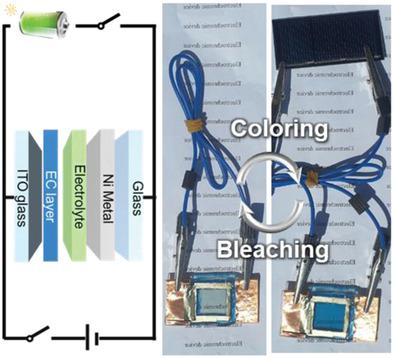当前位置:
X-MOL 学术
›
Adv. Mater. Technol.
›
论文详情
Our official English website, www.x-mol.net, welcomes your
feedback! (Note: you will need to create a separate account there.)
Self-Driven Ni-Based Electrochromic Devices for Energy-Efficient Smart Windows
Advanced Materials Technologies ( IF 6.4 ) Pub Date : 2023-01-29 , DOI: 10.1002/admt.202201688
He Zhang 1, 2 , Jiayun Feng 1 , Fangyuan Sun 2 , Dongyan Zhou 2 , Ge Cao 2 , Shang Wang 1 , Xuanyi Hu 1 , Jingxuan Ma 1 , Fengyu Su 3 , Yanqing Tian 2, 4 , Yanhong Tian 1, 5
Advanced Materials Technologies ( IF 6.4 ) Pub Date : 2023-01-29 , DOI: 10.1002/admt.202201688
He Zhang 1, 2 , Jiayun Feng 1 , Fangyuan Sun 2 , Dongyan Zhou 2 , Ge Cao 2 , Shang Wang 1 , Xuanyi Hu 1 , Jingxuan Ma 1 , Fengyu Su 3 , Yanqing Tian 2, 4 , Yanhong Tian 1, 5
Affiliation

|
Electrochromic devices (ECDs) with adjustable transmittance have opened new opportunities to the development of smart windows for energy-efficiency building. However, the switching between colored and bleached state of conventional ECD will bring extra energy consumption, the design of high-performance ECD with low consumption is still an elusive goal. To address this issue, a self-driven and energy-saving Ni anode-based ECD using Prussian blue as electrochromic material is developed. During the day, it can be colored by solar energy. By contrast, it can spontaneously bleach when the ECD's anode and cathode are short-circuiting using the internal redox potential during the night. It is worth noting that no extra energy is inputted in the coloring-bleaching cycle. In comparison with the ECD using electrolyte with high Ni2+ (K+:Ni2+ = 1:9) or high K+ (K+:Ni2+ = 9:1) concentration with poor optical contrast and cyclic stability (failed <100 cycles), the Ni-based ECD with the electrolyte containing equal amount of K+ and Ni2+ exhibits a high optical contrast (39.45%), good coloration response time (6 s), and excellent stability (1000 cycles). These properties suggest that the Ni-based electrochromic configuration is expected to be a catalyst for the development of energy-storage EC smart window in the future.
中文翻译:

用于节能智能窗的自驱动镍基电致变色器件
透光率可调的电致变色器件 (ECD) 为节能建筑智能窗的开发开辟了新的机遇。然而,传统ECD在有色状态和漂白状态之间的转换会带来额外的能量消耗,设计高性能低功耗的ECD仍然是一个可望而不可即的目标。为了解决这个问题,开发了一种使用普鲁士蓝作为电致变色材料的自驱动和节能的基于镍阳极的ECD。白天,它可以被太阳能着色。相比之下,当 ECD 的阳极和阴极在夜间使用内部氧化还原电位短路时,它可以自发漂白。值得注意的是,在染色-漂白循环中没有输入额外的能量。与使用高Ni 2+电解液的ECD相比(K + :Ni 2+ = 1:9) 或高 K + (K + :Ni 2+ = 9:1) 浓度且光学对比度和循环稳定性较差(失败 <100 个循环),Ni 基 ECD 与含有等量K +和Ni 2+的电解质表现出高光学对比度(39.45%),良好的显色响应时间(6 s)和出色的稳定性(1000次循环)。这些特性表明,镍基电致变色配置有望成为未来储能 EC 智能窗发展的催化剂。
更新日期:2023-01-29
中文翻译:

用于节能智能窗的自驱动镍基电致变色器件
透光率可调的电致变色器件 (ECD) 为节能建筑智能窗的开发开辟了新的机遇。然而,传统ECD在有色状态和漂白状态之间的转换会带来额外的能量消耗,设计高性能低功耗的ECD仍然是一个可望而不可即的目标。为了解决这个问题,开发了一种使用普鲁士蓝作为电致变色材料的自驱动和节能的基于镍阳极的ECD。白天,它可以被太阳能着色。相比之下,当 ECD 的阳极和阴极在夜间使用内部氧化还原电位短路时,它可以自发漂白。值得注意的是,在染色-漂白循环中没有输入额外的能量。与使用高Ni 2+电解液的ECD相比(K + :Ni 2+ = 1:9) 或高 K + (K + :Ni 2+ = 9:1) 浓度且光学对比度和循环稳定性较差(失败 <100 个循环),Ni 基 ECD 与含有等量K +和Ni 2+的电解质表现出高光学对比度(39.45%),良好的显色响应时间(6 s)和出色的稳定性(1000次循环)。这些特性表明,镍基电致变色配置有望成为未来储能 EC 智能窗发展的催化剂。

































 京公网安备 11010802027423号
京公网安备 11010802027423号